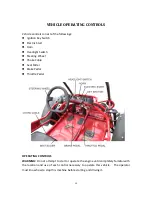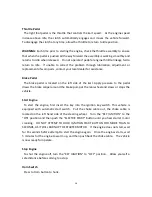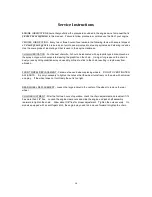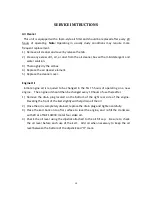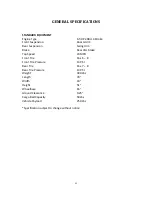
9
operated after mature, supervised instruction and sufficient practice in decongested areas.
Safe operation includes responsibility for the safety of a passenger (if any).
10.
The engine should be stopped when the vehicle is not in use.
11.
The operator and passenger (if any) of this vehicle should always wear a helmet approved by
agencies such as the Department of Transportation (DOT), Safety Helmet Council of America
(SHCA), or Snell Memorial Foundation (SNELL). Most off-road vehicle accident fatalities are
due to head injuries. The operator should also wear face shields or goggles, boots or
closed-toe shoes, gloves, and other appropriate protective clothing.
12.
Loose clothing, long hair, or articles worn by any operator or passenger must be fully
contained, or covered to prevent them from possibly being caught in rotating parts of the
vehicle or the surrounding environment while riding. Failure to obey could endanger the
personal safety of the operator or passenger.
13.
Do not place hands, feet, or any other part of the body or any clothing near the engine, muffler,
wheels, chain, and other rotating parts of the vehicle while riding or running the engine.
Caution must be used in performing required maintenance on or near an operating engine.
Special caution should be taken after the engine has been running, since the engine and other
drive components may be extremely hot.
14.
Wet, slippery, rough, or steep terrain is potentially dangerous and may result in injury if proper
caution is not observed. Slow speeds are required to safely operate this vehicle under those
conditions. The operator must use mature judgment, skill, and experience to choose a speed
suitable for the terrain and riding conditions.
15.
The governor settings for this vehicle's engine must not be tampered with, altered, or changed.
The governor is set by the engine manufacturer and limits the maximum speed of the engine
(and vehicle) and protects the engine from damage. Excessive speeds are potentially
dangerous to the operator and the engine.
16.
Each time before using this vehicle, the fuel supply should be checked. The fuel tank should
never be filled while the engine is running or while the engine is hot. Do not fill tank in a
closed area such as a garage, while smoking, or in the vicinity of an open flame. Do not
overfill the tank. Always follow the directions in the engine owner's manual. There should not
be any fuel in the filler neck. Replace cap tightly to prevent spillage of fuel and potential fire
hazard. After filling tank, move the vehicle at least 15 feet away from spot of filling before
starting.
17.
If the vehicle should start making unusual noise or vibrating abnormally, the engine should be
stopped and the spark plug wire disconnected. The vehicle should then be checked for
damage. Excessive noise or vibration is generally a warning of loose or worn parts.
18.
When making repairs or adjustments to the vehicle which do not involve adjustments to the
engine, the spark plug wire must be disconnected and kept away from the spark plug to
prevent accidental starting. When working on or around, or when restarting engine, use
extreme caution to avoid contact with the muffler, cylinder head, or any other potentially hot
area on or around the engine.
19.
Always perform a Pre-Ride Inspection before starting the engine. See Pre-Ride Inspection
section in this manual.
20.
Always perform a Pre-Ride Inspection before starting the engine. See Pre-Ride Inspection

















